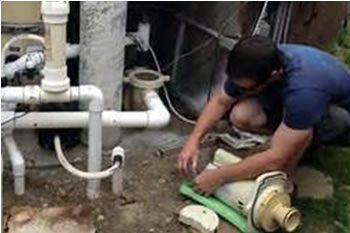Swimming Pool Pump Repair
Your swimming pool pump is the heart of your pool’s circulation system. It is important that it is properly maintained and repaired quickly if a problem arises.
When it is time for a repair on your existing swimming pool pump we have the expertise that comes from 20 years of experience troubleshooting and resolving any issues your pump may have.
Common Problems:
- Leaking Pump
- Air In Pump Basket
- Pump Not Pumping Water
- Noisy Motor
- Motor Wont Start Or Turn On
- Motor Hums But Wont Start
- Intermittent Motor Cycling



SWIMMING POOL PUMP TROUBLESHOOTING GUIDE
Leaking pump? A very common problem is the threaded fitting carrying water out of the swimming pool pump shrinking and allowing water to drip, run and then spray. This can be replaced with a high temp fitting to prevent its re-occurrence. Water may also leak from a worn out mechanical seal. This seal is the separation between the wet end and the dry end (motor) of the pump. This mechanical shaft seal should be replaced.
Air in pump basket? The pump is meant to operate air free. After some time, you may notice air in the basket, especially if you have a clear lid to observe such things. This can reduce filtering efficiency, allow dangerous air to build up in filter, and sometimes prevent your pump from catching prime (being able to move water). The problem is usually located around the pump, above ground. Occasionally, we have to look underground for the source of the air. Air in the pump basket can be caused by something as simple as the water level being too low in the pool.
Pump is not pumping water like usual? Sometimes when we get repair calls like this we’ll find that there is debris in the impeller or a suction line may be plugged. These are usually easy to fix. Other possibilities are internal parts broken in the pump or a leak in the suction line.
Noisy Motor? Inside of your pump’s motor are a front bearing and a rear bearing. These bearings are sealed and cannot be re-packed or re-lubricated. They are replaced when they begin to scream and screech. Bearings can become damaged when the pump has run dry and overheated, or if the pump is put under high loads. A noisy pump can also be cavitation. This sounds less like screeching and more like grinding. This condition is caused by starving the pump for water. We find the cause of the obstruction that is blocking water flow into the pump. It may be the impeller. Finally, noisy pumps can be the sound of components striking one another. The impeller can, on stub shaft models, come loose, and hit against the impeller housing. The internal fan can break and hit against the motor side. Both instances will resolve themselves. At 3450 rpm, it won’t take long for the fan to wear down or the impeller to chew right through the housing. These conditions are rare, and probably will require a new swimming pool pump.
Motor will not start or turn on? First we check that you have power. Is the breaker on? Time clock on? All switches on? Use an electric meter to be sure that voltage is correct. We check that all electrical connections are tight and not corroded or shorted out by bugs or debris. Again, the use of a meter or test lamp will check this with certainty. If there is power going all the way to the motor, the motor may have become shorted across its windings.
Motor hums but will not start? The impeller may be clogged with debris. We check the impeller first. Then we check to see if the shaft on the motor will turn freely, remove the motor from the pump and clean the impeller. If it does spin, we check the capacitor. If it is a stub shaft type motor, we check that the impeller is not hitting the impeller housing.
The capacitor is the black cylinder on the back of the motor, although sometimes it is silver and mounted on top of the motor. We check the capacitor for any issues that it may be having. Sometimes even a fine looking capacitor can be bad. Often a new capacitor of the same rating may need to be installed.
Finally, low voltage can be a cause of a humming but not starting motor. Some new motors are wired 220 volts, so if you hook it up to 110 volts, it will only hum, or cycle. Or perhaps one of the power leads is loose, or shorted. We check with a Multimeter to verify the correct voltage, with a variance of 10% allowed.
Motor Cycling? If the motor runs for a short while, shuts itself off, and turns itself back on later, it may be overheating. Normal motor temperature is over 140 degrees, so all motors run hot. But a cycling motor may indicate that the thermal overload is kicking it off. If this motor was just replaced, we make sure that the electrical supply connections are correct and the wire size is correct for the voltage it is carrying. Low voltage can cause overheating. Inadequate ventilation can cause overheating, so we make sure that the air vents are unobstructed. Usually, old motors that suddenly begin to overheat will need to be replaced. They usually have a short inside, across the windings. And motors are just not rewound anymore like they were in the old days.
